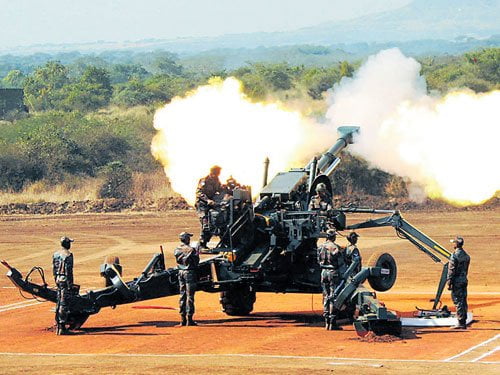According to top defence sources, India has greatly increased its firepower along its borders in the previous two years, with the Army inducting a variety of sophisticated guns and rocket systems for its artillery battalions.
The anticipated capability development and enhancements are part of the Army’s Artillery modernization programmes, which have accelerated in the recent decade. The Regiment of Artillery is also acquiring a variety of Unmanned Aerial Vehicles, including loitering weapons.
The vast bulk of gun and rocket systems are manufactured in-house.
While the majority of the gun systems and guided ammunition ordered in the last three years have been delivered and deployed at the northern and eastern borders, some more gun systems are being procured, according to individuals familiar with the situation.
ADDITIONAL K9 VAJRAS, M777 HOWITZERS
The Army will shortly begin the process of acquiring 100 additional K9 Vajra-T 155 mm/52 calibre tracked self-propelled gun systems, with authorisation already in place from the Defence Acquisition Council (DAC).
“The Request for Proposal will be issued very soon,” claimed a defence source.
However, the sources underlined that there are no urgent intentions to acquire additional M777 howitzers.
After the military standoff with China began in May 2020, the K9 Vajra-T weapons were positioned along the LAC in eastern Ladakh.
According to sources, the device has already been tested along the country’s northern borders.
They further stated that the existing weapons are receiving extra “winterisation kits” in order to resist and operate in the harsh winters of eastern Ladakh. However, the new gun systems that will be purchased will come with nine-item kits.
According to the sources, the seventh regiment of M777 howitzers is being created. The Army had deployed the high-mobility systems, 145 of which were purchased from BAE Systems in the northeast, adding significant firepower to India’s arsenal at the LAC.
The 155mm, 39-calibre towed artillery cannons may be flown and quickly deployed at the frontiers by Chinook helicopters. As News18 reported earlier this month, helipads for Chinook helicopters are being built at all front positions in the northeast to allow for speedy movement of troops and equipment.
The Defence Research Development Organization’s (DRDO) Advanced Towed Artillery Gun System (ATAGS), which was developed and constructed in partnership with Bharat Forge Limited and Tata Advanced Systems Ltd, has completed a series of comprehensive trials. According to the sources cited above, while additional experiments are ongoing, preliminary trial results demonstrate that the specialised towed 155 mm/52 calibre howitzer is a reliable gun system.
According to defence sources, the 130 mm indigenous Sharang gun system’s life and technology are being improved to make it a successful “upgunned” gun with improved range and accuracy.
Three regiments of the gun system are currently operating, and a fourth is being raised, they claimed.
The Army has also installed an updated version of an automated fire control system for artillery weapon systems deployed along the northern frontiers, which can deliver artillery firepower in a faster and more accurate manner.
10 REGIMENTS OF INDIGENOUS PINAKA WEAPON SYSTEM
While the Army presently has four regiments of the Pinaka Multi Launcher Rocket System (MLRS), it has made orders for six more regiments, with deliveries coming soon, according to sources.
According to a second source, “these regiments will be equipped with electronically and mechanically enhanced weapon systems capable of shooting a variety of ammunition across extended ranges.”
According to the source, one regiment has been inducted along the northern borders in high altitude areas following comprehensive validation, and a high altitude firing validation is scheduled.
The Army also intends to install Guided Extended Range rockets for the Pinaka MLRS, which can shoot up to a longer range of 75 kilometres with “considerable accuracy,” according to insiders, adding that the current weapon system will improve artillery firepower’s long-range capacity.
There are now five Grad rocket regiments and three Smerch units in the Army.
‘NEED CONSORTIUM CULTURE IN INDIGENOUS MANUFACTURING’
Swathi, an indigenous weapon-locating radar, has also been inducted and placed along the northern frontiers.
Swathi is a counter-battery radar that detects and tracks incoming artillery and rocket fire and can determine the point of origin for counter-bombing.
In design and performance, the radar is comparable to the ANTPQ-37 radar used by the Army, but it is believed to be more user friendly.
According to the sources cited above, all gun systems purchased in the last five years, with the exception of the Ultra-Light Howitzer, have been manufactured in the country.
“However, instead of granting individual orders to enterprises, a consortia culture that exists globally needs to be implemented in indigenous manufacturing of arms and military systems.”
This will considerably shorten the timetables for local manufacture,” claimed a defence official.
